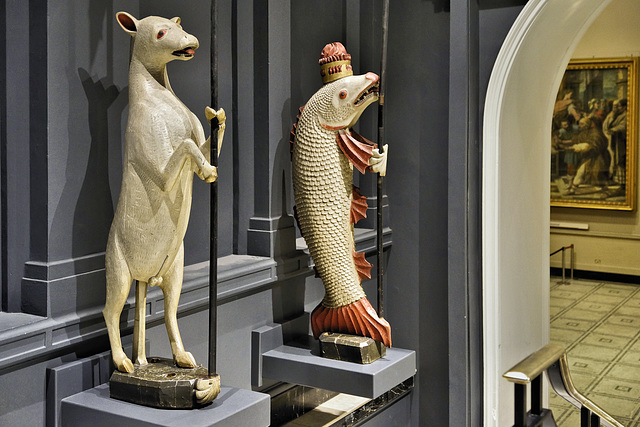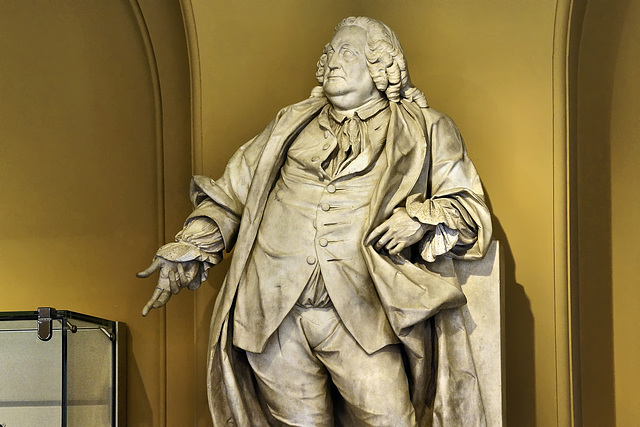Jonathan Cohen's photos
Devotion – Victoria and Albert Museum, South Kensington, London, England
Dacre Beasts: White Ram and Crowned Salmon – Victoria and Albert Museum, South Kensington, London, England
From the Guardian newspaper, July 28, 2000:
The Dacre Beasts, four towering wooden heraldic animals which guarded Dacre Castle in Cumbria for almost 500 years until they found themselves in a London auction room, have been bought by the Victoria and Albert Museum for £420,000, the museum announced yesterday.
The extraordinary figures, each more than six feet tall, all carved from a single early 16th century oak tree, are said to have inspired Tenniel’s illustrations for Alice in Wonderland. Despite their remote location, the beasts became famous in the 19th century through prints, appealing strongly to Victorian fantasies of medieval romance.
The figures – a Red Bull, a Black Gryphon, a White Ram and a Crowned Salmon, concealing a coded history of the Dacre family including an elopement – are regarded as unique survivors of a lost world of English medieval and Tudor heraldic carving. All their peers have gone through rot, fire or deliberate destruction in the Reformation and the Civil War. The Dacre beasts themselves survived a 19th century fire which destroyed most of the castle. Traces of the original paint surface were recently discovered under the Victorian century repainting.
The beasts were made for Thomas Dacre, a formidable soldier who fought with Henry Tudor against Richard III at the Battle of Bosworth, and against the Scots at Flodden.
Dacre Beasts: Red Bull and Black Gryphon – Victoria and Albert Museum, South Kensington, London, England
From the Guardian newspaper, July 28, 2000:
The Dacre Beasts, four towering wooden heraldic animals which guarded Dacre Castle in Cumbria for almost 500 years until they found themselves in a London auction room, have been bought by the Victoria and Albert Museum for £420,000, the museum announced yesterday.
The extraordinary figures, each more than six feet tall, all carved from a single early 16th century oak tree, are said to have inspired Tenniel’s illustrations for Alice in Wonderland. Despite their remote location, the beasts became famous in the 19th century through prints, appealing strongly to Victorian fantasies of medieval romance.
The figures – a Red Bull, a Black Gryphon, a White Ram and a Crowned Salmon, concealing a coded history of the Dacre family including an elopement – are regarded as unique survivors of a lost world of English medieval and Tudor heraldic carving. All their peers have gone through rot, fire or deliberate destruction in the Reformation and the Civil War. The Dacre beasts themselves survived a 19th century fire which destroyed most of the castle. Traces of the original paint surface were recently discovered under the Victorian century repainting.
The beasts were made for Thomas Dacre, a formidable soldier who fought with Henry Tudor against Richard III at the Battle of Bosworth, and against the Scots at Flodden.
"Dr." Joshua Ward – Victoria and Albert Museum, South Kensington, London, England
This marble statue by the Italian-born sculptor Agustino Carlini (1718-1790) depicts his friend the celebrated quack doctor Joshua Ward (1686-1761). The statue may have been originally intended as a monument in Westminster Abbey which, in the event, was never erected. Ward was born in Yorkshire, but moved to London where he invented a medicine called "Joshua Ward’s drop" which was supposed to cure people of any illness they had. In his massive advertising campaign, he claimed that his products would cure everything from gout to scurvy, syphilis and cancer. Made with poisonous ingredients, the fake medicine produced violent sweating and other symptoms as the body tried to rid itself of the toxic substances. In humoral medicine this was considered to be a good thing. His private practice amongst the aristocracy was popular. Although he was an unqualified doctor, his patients included King George II and the writer Horace Walpole. He became extremely wealthy. Yet, despite his quackery, Ward was a renowned philanthropist who opened two hospitals for the poor and who threw money out of his coach as it passed through poor areas. His hand gesture may indicate generosity while his prodigious bulk suggests prosperity.
Handel by Roubiliac – Victoria and Albert Museum, South Kensington, London, England
Louis-François Roubiliac’s statue of George Frederick Handel is a work of 1738 in the Victoria and Albert Museum, London. It was commissioned by the impresario Jonathan Tyers for his famous pleasure gardens in London, Vauxhall Gardens, in order to move his venue upmarket. (The Gardens drew all manner of people and supported enormous crowds, with its paths having an unsavouray reputation as places for romantic assignations.)
The composer is shown in the guise of Orpheus, holding a lyre. Despite the classical allusion, he wears informal contemporary dress: a soft cap, a long shirt open at the neck, a full loose gown, and slippers, one of which lies beneath his right foot. His pose is also casual. He is seated cross-legged, leaning on a pile of bound scores of his works, including Alexander’s Feast, which was completed the same month the statue was finished. The statue is unprecedented, for not only was the sitter portrayed with startling informality, but it was the first life-size marble depicting a living artist. Until this date such public statues were erected only for monarchs, noblemen or military leaders.
Roubiliac was a native of France, although his known surviving work was executed in England. He was trained in Lyon, later working in Dresden under a leading Baroque sculptor, Balthasar Permoser (1651–1732), and then studying in Paris before moving to London in about 1730. All his known surviving works were executed in Britain. Handel is his earliest known independent sculpture. When it went on display in Vauxhall Gardens in 1738 it proved an immediate success, helping to establish Roubiliac as one of the leading sculptors in England. He specialized in portrait busts and funerary monuments, and was renowned for his handling of marble, particularly his creation of subtle surface textures.
Hanging Out at the V&A – Victoria and Albert Museum, South Kensington, London, England
The V&A Rotunda Chandelier (often known as V&A Chandelier and originally called Ice Blue and Spring Green Chandelier) is a glass sculpture by Dale Chihuly. It hangs under the glass rotunda at the entrance to the Victoria and Albert Museum in South Kensington, London. Considered to be an artwork as much as a source of light, it was installed in 1999 and then substantially altered and enlarged to its current size in 2001, coinciding with a V&A exhibition of the artist’s work.
The chandelier has dimensions of 27 × 12 × 12 feet (8.2 × 3.7 × 3.7 m) and is made of blown glass. It was created with blue, green, and yellow glass composed of fused, relatively small swirling tendrils and sharp protruding edges that extend outward from every side. The top and the bottom are composed of a more rounded shape, while a smaller round arrangement of glass hangs in the middle. The top has a notable protrusion, mainly of light blue glass, which then develops into shades of yellow and green as the viewer’s eye moves downwards.
The massive size of the chandelier and the delicate nature of the glass meant the museum had had to make special accommodations to house and maintain it. Before the chandelier could even be installed, the V&A had to reinforce the ceiling. Cleaning the chandelier requires specialist techniques. It is cleaned piece by piece by a technician on a raised platform. The technician moves slowly around the chandelier cleaning each individual spike and tendril of glass with an antistatic wand made of plastic filaments. This has to be carried out before the museum opens, a process that takes several days.
Royal Medalions – Victoria and Albert Museum, South Kensington, London, England
Prince Albert – Victoria and Albert Museum, South Kensington, London, England
The Main Entrance – Victoria and Albert Museum, South Kensington, London, England
The inscription around the main door arch was adapted from Sir Joshua Reynolds: "The excellence of every art must consist in the complete accomplishment of its purpose."
Jump to top
- ipernity © 2007-2025
- Help & Contact
|
Club news
|
About ipernity
|
History |
ipernity Club & Prices |
Guide of good conduct
Donate | Group guidelines | Privacy policy | Terms of use | Statutes | In memoria -
Facebook
Twitter










